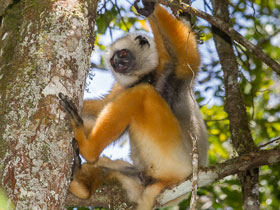The diademed sifaka (Propithecus diadema), or diademed simpona
The diademed sifaka (Propithecus diadema), or diademed simpona, is an endangered species of sifaka, one of the lemurs endemic to certain rainforests in eastern Madagascar.
Appearance
Propithecus diadema is a species of strepsirrhine primate in the family Indriidae. Propithecus diadema is the size of a medium-sized dog: body length 52 cm, tail 46.5 cm, weight 6 to 7.25 kg. It has a long white coat, tinged with black on the neck and the top of the head. Its forelimbs and hind limbs are golden, and its feet are black.
Lifestyle and distribution
Propithecus diadema lives in family groups of 2-5 individuals, occupying an area of 20 ha. It inhabits the tropical forests of Madagascar in the north, from the Manguru River to the Antainambalana River. Propithecus diadema feeds on leaves, flowers and fruits. It reaches sexual maturity at the age of 2-3 years. The female produces young (1 brood) every year.
Life span is 25-30 years.
The life of this species in the wild is little studied, and it has not been possible to obtain offspring from it in captivity.
Subspecies
Three subspecies are sometimes distinguished:
- Propithecus diadema diadema;
- Propithecus diadema marshi;
- Propithecus diadema perrieri.
Conservation issues
The diademed sifaka is classified as critically endangered on the IUCN Red List, and is listed in CITES Appendix I. As of the year 2002, population estimates for the species range between 6,000 and 10,000 individuals. The primary threat is habitat reduction due to shifting cultivation by native peoples. This threat is also present even within designated national parks, which are sufficiently distant from the center of government, that enforcement of existing national laws protecting Propithecus diadema habitat is problematic. Pressures of population growth in central and eastern Madagascar are causing many of the rural poor to seek subsistence by seizing whatever forest lands are available and undertaking slash-and-burn tactics as their initial step in a shifting cultivation system. Returns from such land use are usually meager, yielding small amounts of charcoal, firewood or grass crop for grazing of zebu.

















































